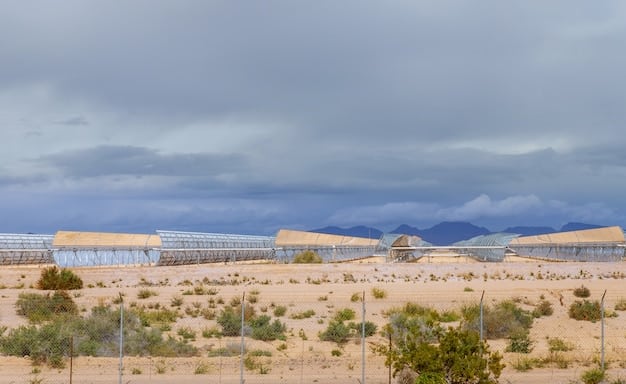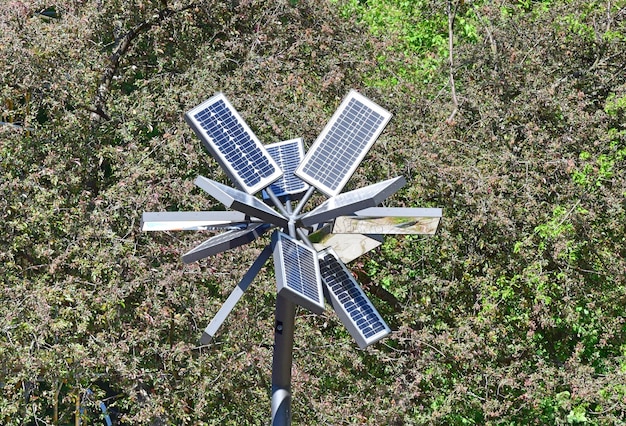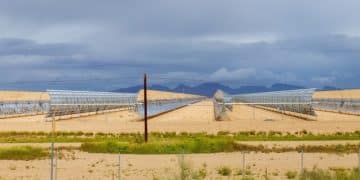Renewable Energy Tech: Driving Sustainability in the US Market

Renewable Energy Tech is revolutionizing the US market by offering innovative solutions like advanced solar panels, enhanced battery storage, and smart grids, all aimed at boosting sustainability and reducing carbon emissions.
The United States is experiencing a significant shift towards sustainable practices, and renewable energy tech is at the forefront of this transformation. From solar and wind power to innovative energy storage and smart grid technologies, the US market is seeing remarkable advancements that are driving sustainability and reducing the nation’s carbon footprint.
Renewable Energy Sources: The Foundation of Sustainability
Renewable energy sources are the backbone of a sustainable energy future in the US. These sources, including solar, wind, hydro, and geothermal, provide clean alternatives to fossil fuels, significantly reducing greenhouse gas emissions and mitigating climate change.
Solar Power Advancements
Solar power has seen tremendous growth in recent years, thanks to technological advancements that have increased efficiency and reduced costs. Innovations like bifacial solar panels and improved photovoltaic materials are making solar energy more accessible and affordable for homes and businesses alike.
Wind Energy Innovations
Wind energy is another crucial component of the renewable energy mix in the US. With larger and more efficient turbines, wind farms are now capable of generating more electricity than ever before. Offshore wind projects are also gaining momentum, offering a vast untapped resource for clean energy production.
- Bifacial Solar Panels: Capture sunlight from both sides, increasing energy yield.
- Enhanced Turbine Technology: Larger blades and improved designs for greater efficiency.
- Offshore Wind Farms: Tapping into stronger and more consistent wind resources.
These advancements are not only boosting the production of clean energy but also creating jobs and stimulating economic growth in the renewable energy sector. As technology continues to evolve, renewable sources will play an even greater role in meeting the energy needs of the United States.

Energy Storage Solutions: Addressing Intermittency Challenges
One of the main challenges with renewable energy sources like solar and wind is their intermittency – the fact that they are not always available when needed. Energy storage solutions, such as batteries and pumped hydro storage, are essential for addressing this challenge and ensuring a reliable supply of clean energy.
Battery Technology Advancements
Battery technology has made significant strides in recent years, with improvements in energy density, lifespan, and cost. Lithium-ion batteries are now widely used in electric vehicles and grid-scale energy storage systems, providing a flexible and efficient way to store and release electricity as needed.
Pumped Hydro Storage
Pumped hydro storage is another proven technology for storing large amounts of energy. This method involves pumping water from a lower reservoir to a higher reservoir during periods of low demand, and then releasing the water to generate electricity when demand is high.
These energy storage solutions are crucial for integrating renewable energy into the grid and ensuring a stable and reliable power supply. As technology continues to advance, energy storage will become even more important for enabling a fully sustainable energy system.
Smart Grid Technologies: Enhancing Grid Efficiency and Reliability
Smart grid technologies are transforming the way electricity is distributed and managed in the US. These technologies, including advanced sensors, communication networks, and data analytics, enable a more efficient and reliable grid, capable of handling the increasing amounts of renewable energy being generated.
Advanced Metering Infrastructure (AMI)
AMI systems provide real-time data on energy consumption, allowing utilities to better manage demand and optimize grid operations. Smart meters also empower consumers to make informed decisions about their energy usage, reducing waste and saving money.
Grid Automation and Control Systems
Grid automation and control systems use advanced algorithms to optimize the flow of electricity and respond quickly to disruptions. These systems can automatically reroute power and isolate faults, minimizing outages and improving grid reliability.

- Real-Time Monitoring: Continuous data collection for optimized grid management.
- Demand Response Programs: Incentivizing consumers to reduce energy usage during peak times.
- Fault Detection and Isolation: Rapid response to grid disruptions for improved reliability.
Smart grid technologies are essential for modernizing the electricity grid and enabling the integration of renewable energy sources. By improving efficiency and reliability, these technologies are helping to build a more sustainable and resilient energy system in the US.
Policy and Investment: Fueling Renewable Energy Growth
Government policies and investments play a crucial role in driving the growth of renewable energy in the US. Incentives, tax credits, and regulations can create a level playing field for renewable energy technologies and encourage innovation and deployment.
Federal Tax Credits and Incentives
Federal tax credits, such as the Investment Tax Credit (ITC) for solar energy and the Production Tax Credit (PTC) for wind energy, have been instrumental in driving down the cost of renewable energy and making it more competitive with fossil fuels.
State Renewable Portfolio Standards (RPS)
Many states have adopted RPS policies, which require utilities to source a certain percentage of their electricity from renewable sources. These policies create a guaranteed market for renewable energy and incentivize the development of new projects.
Supportive policies and investments are essential for creating a sustainable energy future in the US. By leveling the playing field and encouraging innovation, governments can help accelerate the adoption of renewable energy technologies and reduce the nation’s carbon footprint.
Challenges and Opportunities in the Renewable Energy Sector
While the renewable energy sector in the US has made significant progress, there are still challenges that need to be addressed. These challenges include the need for improved grid infrastructure, streamlined permitting processes, and increased public awareness and acceptance.
Grid Infrastructure Upgrades
The existing grid infrastructure in the US was not designed to handle large amounts of renewable energy. Upgrading the grid to accommodate more renewable energy sources will require significant investments in new transmission lines, substations, and smart grid technologies.
Permitting and Regulatory Streamlining
The permitting process for renewable energy projects can be lengthy and complex, often delaying or even preventing development. Streamlining the permitting process and reducing regulatory barriers can help accelerate the deployment of renewable energy technologies.
Despite these challenges, the renewable energy sector in the US offers tremendous opportunities for growth and innovation. By addressing the challenges and capitalizing on the opportunities, the US can build a sustainable energy future that benefits both the environment and the economy.
The Future of Renewable Energy Tech in the US
The future of renewable energy tech in the US looks promising, with continued innovation and investment driving down costs and increasing efficiency. As technology advances and policies become more supportive, renewable energy is poised to play an even greater role in meeting the energy needs of the United States.
Emerging Technologies and Innovations
New technologies, such as advanced geothermal systems, wave energy converters, and hydrogen fuel cells, hold great potential for expanding the renewable energy mix. These technologies are still in the early stages of development, but they could play a significant role in the future of sustainable energy.
The Role of Collaboration and Partnerships
Collaboration and partnerships between government, industry, and academia are essential for driving innovation and accelerating the adoption of renewable energy technologies. By working together, these stakeholders can address the challenges and capitalize on the opportunities in the renewable energy sector.
| Key Point | Brief Description |
|---|---|
| ☀️ Solar Power | Advancements in panels increase efficiency and reduce costs. |
| 💨 Wind Energy | Larger turbines and offshore projects enhance energy production. |
| 🔋 Energy Storage | Batteries and pumped hydro address intermittency challenges. |
| 🌐 Smart Grids | Improve efficiency and reliability of energy distribution. |
Frequently Asked Questions
▼
The primary sources include solar, wind, hydro, and geothermal. Solar and wind have seen the most significant growth due to technological advancements and decreasing costs.
▼
Energy storage, like batteries and pumped hydro, addresses the intermittent nature of solar and wind power, ensuring a consistent and reliable energy supply even when the sun isn’t shining or the wind isn’t blowing.
▼
Smart grids use advanced sensors, communication networks, and data analytics to enhance grid efficiency and reliability. They enable better management of energy distribution and can handle increased renewable energy inputs.
▼
Federal tax credits like the ITC and PTC, along with state Renewable Portfolio Standards (RPS), incentivize renewable energy development and create a market for clean energy sources.
▼
Future trends include emerging technologies like advanced geothermal systems and wave energy converters, along with increased collaboration between government, industry, and academia to drive innovation and adoption.
Conclusion
Renewable energy tech innovations are crucial for achieving sustainability in the US market. By embracing advancements in solar, wind, energy storage, and smart grid technologies, and with supportive policies and investments, the United States can transition towards a cleaner, more sustainable energy future that benefits both the environment and the economy.





